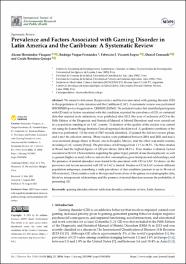Mostrar el registro sencillo del ítem
Prevalence and Factors Associated with Gaming Disorder in Latin America and the Caribbean: A Systematic Review
| dc.contributor.author | Hernández-Vásquez, Akram | es_ES |
| dc.contributor.author | Vargas-Fernández, Rodrigo | es_ES |
| dc.contributor.author | Visconti-Lopez, Fabriccio J. | es_ES |
| dc.contributor.author | Comandé, Daniel | es_ES |
| dc.contributor.author | Bendezu-Quispe, Guido | es_ES |
| dc.date.accessioned | 2022-11-23T16:53:38Z | |
| dc.date.available | 2022-11-23T16:53:38Z | |
| dc.date.issued | 2022-08-15 | |
| dc.identifier.uri | https://hdl.handle.net/20.500.13053/7227 | |
| dc.description.abstract | “We aimed to determine the prevalence and factors associated with gaming disorder (GD) in the population of Latin America and the Caribbean (LAC). A systematic review was performed (PROSPERO protocol registration: CRD42021230565). We included studies that identified participants with GD and/or factors associated with this condition, reported the prevalence of GD, or contained data that assisted in its estimation, were published after 2013 (the year of inclusion of GD in the Fifth Edition of the Diagnostic and Statistical Manual of Mental Disorders) and were carried out in a population residing in an LAC country. Evaluation of the quality of the studies was carried out using the Joanna Briggs Institute Critical appraisal checklist tool. A qualitative synthesis of the data was performed. Of the total of 1567 records identified, 25 passed the full-text review phase, and 6 met the selection criteria. These studies were published between 2018 and 2021 and had a cross-sectional design (three in Brazil, one in Ecuador, Mexico, and the other was multi-country, including a LAC country [Peru]). The prevalence of GD ranged from 1.1% to 38.2%. The three studies in Brazil had the highest figures of GD prevalence (20.4–38.2%). Four studies evaluated factors associated with GD. Characteristics regarding the game (type), pattern of use (hours played), as well as gender (higher in men), tobacco and alcohol consumption, poor interpersonal relationships, and the presence of mental disorders were found to be associated with GD in LAC. Evidence on the prevalence and factors associated with GD in LAC is limited. Studies on GD in LAC evaluate different population subgroups, describing a wide prevalence of this condition (present in up to 38 out of 100 evaluated). Characteristics such as the type and hours of use of the games, sociodemographic data, lifestyles, interpersonal relationships, and the presence of mental disorders increase the probability of presenting GD.“ | es_ES |
| dc.format | application/pdf | es_ES |
| dc.language.iso | eng | es_ES |
| dc.publisher | MDPI | es_ES |
| dc.rights | info:eu-repo/semantics/openAccess | es_ES |
| dc.rights.uri | https://creativecommons.org/licenses/by/4.0/ | es_ES |
| dc.subject | gaming disorder; internet addiction disorder; systematic review; Latin America | es_ES |
| dc.title | Prevalence and Factors Associated with Gaming Disorder in Latin America and the Caribbean: A Systematic Review | es_ES |
| dc.type | info:eu-repo/semantics/article | es_ES |
| dc.identifier.doi | https://doi.org/10.3390/ijerph191610036 | es_ES |
| dc.type.version | info:eu-repo/semantics/publishedVersion | es_ES |
| dc.publisher.country | CH | es_ES |
| dc.subject.ocde | http://purl.org/pe-repo/ocde/ford#3.03.00 | es_ES |
Ficheros en el ítem
Este ítem aparece en la(s) siguiente(s) colección(es)
-
SCOPUS [380]


